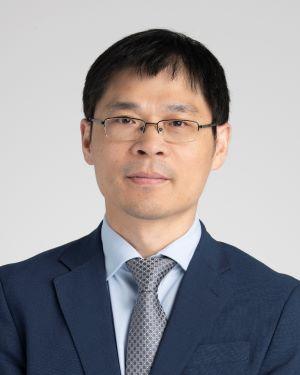Research News
11/11/2024
Combination glioblastoma treatment cures the disease in preclinical models of 'untreatable' drug-resistant brain cancer
Targeting multiple immune cells greatly improved glioblastoma life expectancy in preclinical models of treatment-resistant brain cancer with a 60% overall cure rate.

Cleveland Clinic researchers from the laboratory of Peiwen Chen, PhD, have developed a glioblastoma treatment strategy that has had a 60% cure rate in preclinical models. The treatment is a combination therapy consisting of an FDA-approved immunotherapy (anti-PD1) and two compounds that block processes called macrophage and microglia infiltration, where immune cells that are meant to help our brains instead contribute to tumor growth.
Results published in the Journal of Clinical Investigation showed the triple combination therapy provided long-lasting protection from future tumors, providing hope that new options can be developed for what is considered an “uncurable” disease.
Unravelling the relationship between microglia, macrophages and cancer
Microglia and macrophages are two types of key immune cells that have distinct origins and roles in the brain. Microglia act like patrolling guards for our brains, regularly sweeping through to identify problems, repair damage and call for backup if necessary. Macrophages are a type of white blood cell that can be called into the brain to take care of threats and clean up damage when microglia alone are not enough. In glioblastoma, brain tumors can make their own macrophages and microglia, and “recruit” our body’s immune cells to their side. These tumor-specific immune cells are collectively referred to as tumor-associated macrophages (TAMs). They promote tumor progression and suppress tumor-fighting immune cells.
Dr. Chen explains that glioblastoma is highly infiltrated with immunosuppressive TAMs. For this reason, glioblastoma tumors do not respond well to immunotherapies that use a patient’s own immune system to fight cancer cells. Many drug developers have tried to block macrophage and microglia function in glioblastoma, but they have not been successful.
Nobody, says Dr. Chen, has tried to block both macrophages and microglia at the same time.
Using context-dependent combination therapies to improve glioblastoma lifespans
Dr. Chen’s research team had previously shown that glioblastoma tumors can have unique TAM signatures based on the specific genetic mutations driving the cancer. These context-dependent TAM profiles require context-dependent TAM therapy.
For example, they had previously found that mutations in a common cancer gene called PTEN can in turn “turn on” a different gene called LOX, which promotes macrophage infiltration into the tumor without affecting microglia. They had similarly found that a different driver of glioblastoma called CLOCK “turns on” a gene called OLFML3, which in turn promotes immunosuppressive microglia but not macrophages.
Simply blocking LOX in the context of PTEN-associated tumors or blocking OLFML3 in CLOCK-associated tumors is not enough to cure glioblastoma on its own.
To see the relationship among immune cells in brain tumors, Dr. Chen and his team analyzed the single-cell RNA sequencing (scRNA-seq) data from glioblastoma patient tumors. They were surprised to see that macrophage-specific gene signatures (i.e. LOX) and microglia-specific gene signatures (i.e. CLOCK) were never “turned on” at the same time. Image analyses also showed that macrophages and microglia did not overlap in a tumor.
“Because they’re both immune cells in the brain tumor microenvironment, and because they can both help tumor progression and induce immunosuppression, people think these two cell types get along like sisters. What we found is that they actually compete like rivals,” Dr. Chen says. “When you stop microglia from working in the tumor, tumor-associated macrophages explode in numbers. The opposite is true, too – blocking macrophages increases microglia density in the tumor. It creates a net zero effect. Understanding this competitive relationship could be the key to developing better therapies by targeting both macrophages and microglia.”
Researchers tested blocking genes tied to microglia (OLFML3) and macrophages (LOX) independently and in combination with anti-PD1 immunotherapy, which generally fails to combat glioblastoma on its own. Blocking the genes individually led to a moderate lifespan increase. Shockingly, the triple therapy (LOX inhibition + CLOCK-OLFML3 inhibition + anti-PD1) was highly effective in PTEN-deficient glioblastoma; tumors disappeared in over 60% of cases. The triple therapy even protected the cured subjects when researchers tried to reintroduce tumors.
“Our bodies want to help us fight a tumor - we just need to understand how to help it along,” Dr. Chen says. “No patient is the same – success is dependent on finding out the context-specific working mechanism and then designing personalized therapy.”
Featured Experts
News Category
Related News
Research areas
Want To Support Ground-Breaking Research at Cleveland Clinic?
Discover how you can help Cleveland Clinic save lives and continue to lead the transformation of healthcare.
Give to Cleveland Clinic